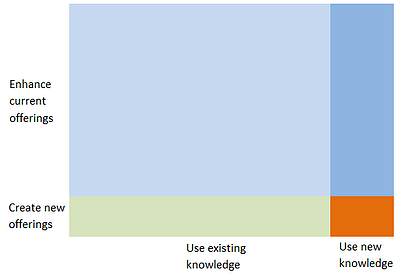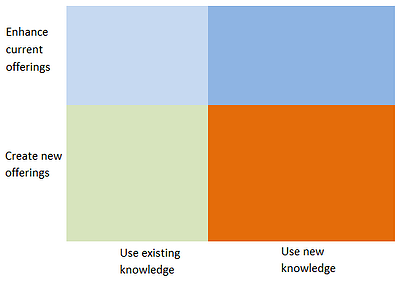"You cannot outperform a marketplace if you adhere to its conventions".
- Jean-Marie Dru, CEO of TBWA
Facebook, the largest social network worldwide, is still thriving and growing. However, the company bought both WhatsApp and Instagram and merged them into Meta Platforms. But what happened exactly, and why did Facebook need to do this?
The answer is simple enough: WhatsApp and Instagram outperform Facebook. These social networks attracted nearly one million new users per day, a number Facebook could not match. Particularly young users, the digital natives, had changed their communication patterns and started to use alternative channels.
What this acquisition reveals is that the pace of change is increasingly accelerating. Market leaders are threatened by new players that disrupt their business models. Consider the progressive turnover rate of the Fortune 500 (Figure 1), and how even well-established players in mature markets can lose market share in an increasingly short time span. Look at Dell and HP, who both were the leading vendors in the personal computer space – until they suddenly weren’t. Both didn’t recognize the shift in consumer demands – their traditional customer base has started to use new technologies to cope with daily tasks they traditionally have used personal computers for.
Disruptive Technologies
Massachusetts Institute of Technology identified the Top 5 Disruptive Technologies that will impact markets and business models in the future. Among them are:
- Blockchain
- Artificial Intelligence and Machine Learning
- Cloud Services
- Internet of Things
-
Cybersecurity
Customer demands are aligned with these changes and shift accordingly. As a result, healthy organizations are nowadays undergoing continuous transformation processes. Market leadership and the implementation of proven business models are not an excuse for stagnancy anymore - today’s leaders are increasingly becoming tomorrow’s followers. Take a look at the example of Nintendo, which was the market leader in the videogame industry in 2007 with a 36% market share, and is now being outsold by Sony and Microsoft with their next-generation consoles.
Globalized economies offer organizations more choices than ever. A direct result is a stronger and more aggressive competition with increasing numbers of new organizations entering existing market segments. Due to new technological developments market entry levels are lowered, which allows small companies to gain traction and compete with established players, and outsiders to frequently enter new territories. Today’s economic landscapes are more dynamic, fast-paced, and entrepreneurial than ever before.
Disruption as an opportunity
In this context, disruptive innovation presents itself as an opportunity for growth in organizations. Executives often believe that they can solve the majority of their problems with already available technology, and that breakthrough ideas solve only a few of their challenges, if at all. In addition, they believe that the majority of improvable profitability will come from raising the efficiency of current activities, and only a minor share of future profit increases will be derived from genuinely new activities.
But is that really the case? Let’s have a look:

Would you focus on a market segment the size of the orange block? Nobody would. So why should we try to do so anyway? The reason is that this segment will grow over time and that this now small market segment will dominate revenue streams in the future. Let’s take a closer look:

Consider the WorldWideWeb and its first steps. It was essentially designed with a “TV and Print” mindset, trying to enhance old business models and concepts - they “colonized” the perception of the WorldWideWeb and the mindset of its users by limiting the horizons of ideas to old constraints and borders. Only after the mindset changed, and new possibilities which the WorldWideWeb offered were explored and harnessed, new products and services were created (social networking, crowdfunding, free education, scientific collaboration, blogging, etc.).
How can organizations embrace disruption?
Think about the following factors if you want to enable your organization to embrace disruptive innovation:
1. Understand where the limits of your business model are
Organizations have to understand what the prevailing conventions of their current business model are before they can challenge and change them, and effectively disrupt the underlying patterns to create something new. Copying this shift to an organization's culture and mindset requires a thorough analysis of the status quo. They need to “anchor” innovation in their current culture to accelerate adoption and generate quick success, and they need to “decolonize” their perception of available opportunities to achieve long-term success.
2. Don’t follow disruptive competitors
If a disruptive innovation meets the market requirements existing players often have not acquired the expertise or the cost-effectiveness that disruptive players have. See how Tesla has raised the technological bars of the battery market for cars in a way no existing car manufacturer could in the past - and is still not able to accomplish today.
Organizations are often penalized for “following”, and this results in them becoming an insignificant force or even shutting down completely. Pursuing disruptive innovation early on enables existing organizations to adapt to changes so that when the technology is actually meeting market demands they are not outperformed by disruptive rivals.
3. Listen to your consumers - but not all the time
Consumers are initially not interested in disruptive innovations because they aren’t meeting their demands yet - but they will make the transition as soon as they do. Organizations that are primarily focusing on demands that can be met in the short term will be outperformed by disruptive competitors. They should identify and target new markets and new customers who find value in their own disruptive offerings.
4. Evaluate disruptive innovation with non-standard metrics
By their nature, disruptive innovations will offer only low ROIs in the short-term - but long-term successes matter. Keep in mind that the impact of disruptive technologies will increase as soon as markets demand and even require them. If an organization anticipates that the conversion will happen in an acceptable time frame it should enable itself to invest in them and defend them against short-term goals.
5. Organize disruptive activities separately
What we have seen in numerous organizations is that disruptive investments are separated into self-sufficient and autarkic business units. This allows them to create the strategic, tactical, and operational processes appropriate for their market and ensures that they are not measured against the standards of already existing business units. It also limits the risk organizations expose themselves to, as those units have to ensure profitability on their own and do not receive financial support from the parent organization.
How to find disruptive innovations?
Working with nearly 200 organizations over the last years HYPE consulting team has identified the following best practices to identify breakthrough ideas successfully:
- Continuously challenge conventional wisdom and enable yourself to explore alternative possibilities. Ask for new ideas to create new things with new technologies.
- Encourage failure. Don’t fear it - fail fast if it happens. Empower stakeholders to take risks and encourage entrepreneurial thinking.
- Create context for innovation. Align your innovation program with your organizational targets
- Ask everybody in your organization for new ideas, not just R&D or New Product Development
- Run Open Innovation campaigns. Talk to your vendors, suppliers, academics, and customers – your biggest fans!
- Run facilitated, cross-sectional, or functional internal campaigns with diverse groups of people
- Establish a decision-making process that enables evaluators to identify breakthrough ideas
- Keep collecting feedback throughout the process
Summary
In today’s economies, disruptive innovation is more than ever seen as a chance to outperform existing competition. What organizations have to acknowledge is that disruptive changes will happen - if they are on board or not. Embracing disruption enables organizations to control potential risks and to grow even in highly competitive environments.
As a result, organizations should ask themselves: Should a new idea change the way you do things – or should it change the things you do?








